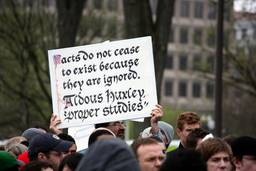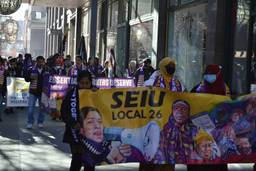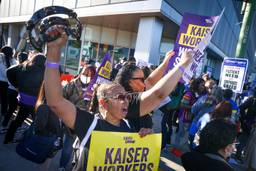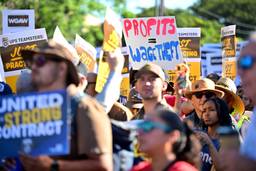(Editor’s note: Art Levine appeared on Democracy Now! this morning to discuss the new attacks on public-sector workers and unions with Michael Zweig and the New York TImes’ Steven Greenhouse. He appears at the 32-minute mark.)
Years of demonizing public employee unions as part of a right-wing assault against the labor movement now seems about to pay off. That’s due in part to state budgets that have been driven near bankruptcy largely by the Wall Street-led crash, and the political cover provided by otherwise liberal Democrats such as New York Governor Andrew Cuomo. He is seeking a reasonable-sounding one-year pay freeze that adds a bipartisan patina to the growing union-bashing.
As the New York Times reported on Tuesday, “Faced with growing budget deficits and restive taxpayers, elected officials from Maine to Alabama, Ohio to Arizona, are pushing new legislation to limit the power of labor unions, particularly those representing government workers, in collective bargaining and politics.”
To some observers, this attack against public employee unions — abetted by right-wing misinformation campaigns that unions and their allies are just starting to counter—so profoundly threatens the labor movement that it poses a broader danger to the economy while strengthening the “Winner-Takes-All” politics that has dominated public policy for decades.
Veteran labor activist Stewart Acuff, the chief of staff for the 50,000-member Utility Workers Union of America and co-author of Getting America Back to Work, says, “This is a very serious effort by the radical right wing to cripple the American labor movement and remove it as a serious force in American life. They want unfettered, unrestricted corporate power, and the only thing standing in the way of absolute corporate domination of our society and what’s left of our democracy is the American labor movement.”
Sound like hyperbole? Take a look at the far-reaching goals of some governors in mostly Republican-led states, as the Times reported:
In some cases — mostly in states with Republican governors and Republican statehouse majorities — officials are seeking more far-reaching, structural changes that would weaken the bargaining power and political influence of unions, including private sector ones.
For example, Republican lawmakers in Indiana, Maine, Missouri and seven other states plan to introduce legislation that would bar private sector unions from forcing workers they represent to pay dues or fees, reducing the flow of funds into union treasuries. In Ohio, the new Republican governor, following the precedent of many other states, wants to ban strikes by public school teachers.
Some new governors, most notably Scott Walker of Wisconsin, are even threatening to take away government workers’ right to form unions and bargain contracts…
Union leaders particularly dread the spread of right-to-work laws, which prevail in 22 states, almost all in the South or West. Under such laws, unions and employers cannot require workers to join a union or pay any dues or fees to unions to represent them.
With organized labor now having more public employee workers than private sector workers, taking away pension gains, cutting off funds, and weakening organizing rights for public employees — who are protected by state laws, not federal labor law — could lower wages and benefits across the economy and undermine the union movement itself, union advocates say.
The challenge is convincing the broader progressive movement — and the public — to stand up for public employee unions that have been caricatured and smeared as generally overpaid, inept and lazy. A start at making the case for public employees unions has begun with AFSCME’s “Stop the Lies” campaign (see video below), but its credibility will only be enhanced when those outside the union movement echo these same concerns and challenge anti-union myths. (For instance, it’s not widely known that public employee workers with the same level of education and experience as private sector workers earn about the same or less as those in the private workfororce.)
In a little-noticed fact sheet on union pensions, AFSCME also points out:
Nationally, the average AFSCME member earns less than $45,000 per year and receives a pension of approximately $19,000 per year after a career of public service. AFSCME members typically contribute towards the cost of their pension. While government employers have often failed to faithfully contribute to their employees’ plans, public workers have contributed year in and year out. In fact, taxpayers shouldered just 14.3% of all pension funding in the eleven year period ending in 2007.
Some confidential but preliminary union public opinion research shows that the broader public has heard relatively little positive news about public employee unions, but they are open to messages excoriating GOP leaders for engaging in political payback against unions and advancing a corporate agenda. Whether the public will actually get to hear those messages in an effective, highly visible way is still very much an open question.
At a AFSCME-sponsored meeting of union activists in mid-December, union leaders referred to successful campaigns to beat back the anti-tax measures in California, Colorado and Massachusetts on the ballot; those right-wing efforts were fueled in part by bashing public employees and their unions. These local leaders talked about taking their case to the media and, in some cases, forming broader coalitions.
Yet when 60 Minutes looked at the state budget crisis, how many people were exposed to AFSCME’s press release rebuttal that quoted the union’s president as saying:
Chris Christie is more interested in scoring political points than solving state and local budget challenges and getting the economy moving. The fact is, hundreds of thousands of public employees, just like private sector employees, have been laid off and taken pay and benefit cuts – even as Wall Street executives lined their pockets with taxpayer money and took home huge bonuses. And as Steve Kroft’s report noted, much of the pension problem stems from the fact that politicians did not contribute to their pension funds. …
The challenge can be met if state and local governments, began contributing just 1.5 percent more of their budgets toward their pension funds in the years ahead.
The long term solution to state and local fiscal challenges is a robust economy – one that is creating jobs and replenishing tax revenue….
For now, union activists believe it’s possible that the public will be exposed to a more positive perspective about public employees and the truth about their salaries and benefits, but, in reality, it’s a steep uphill climb that’s made even harder by hundreds of millions in corporate spending and the power of Fox News.
A potential starting place is a new AFSCME video that will have more power if its perspective is taken up by the broader progressive movement that must start understanding what’s at stake if unions are crippled:

I hope you found this article important. Before you leave, I want to ask you to consider supporting our work with a donation. In These Times needs readers like you to help sustain our mission. We don’t depend on—or want—corporate advertising or deep-pocketed billionaires to fund our journalism. We’re supported by you, the reader, so we can focus on covering the issues that matter most to the progressive movement without fear or compromise.
Our work isn’t hidden behind a paywall because of people like you who support our journalism. We want to keep it that way. If you value the work we do and the movements we cover, please consider donating to In These Times.





